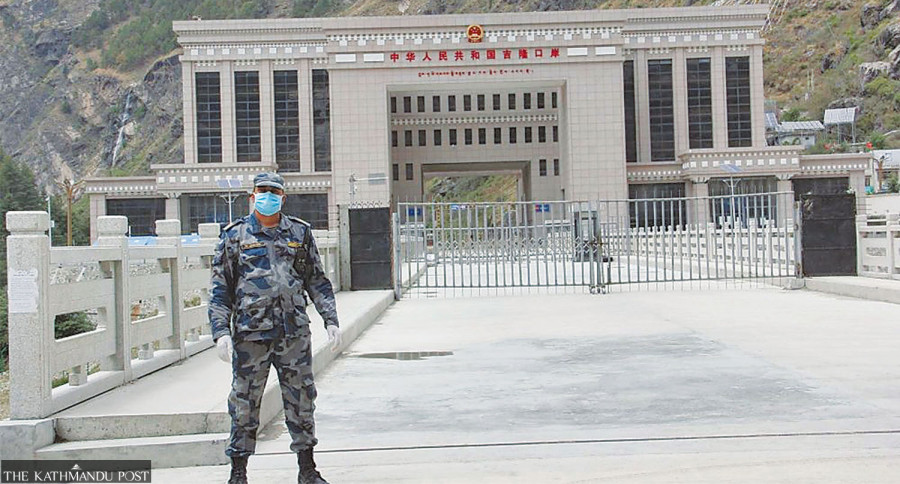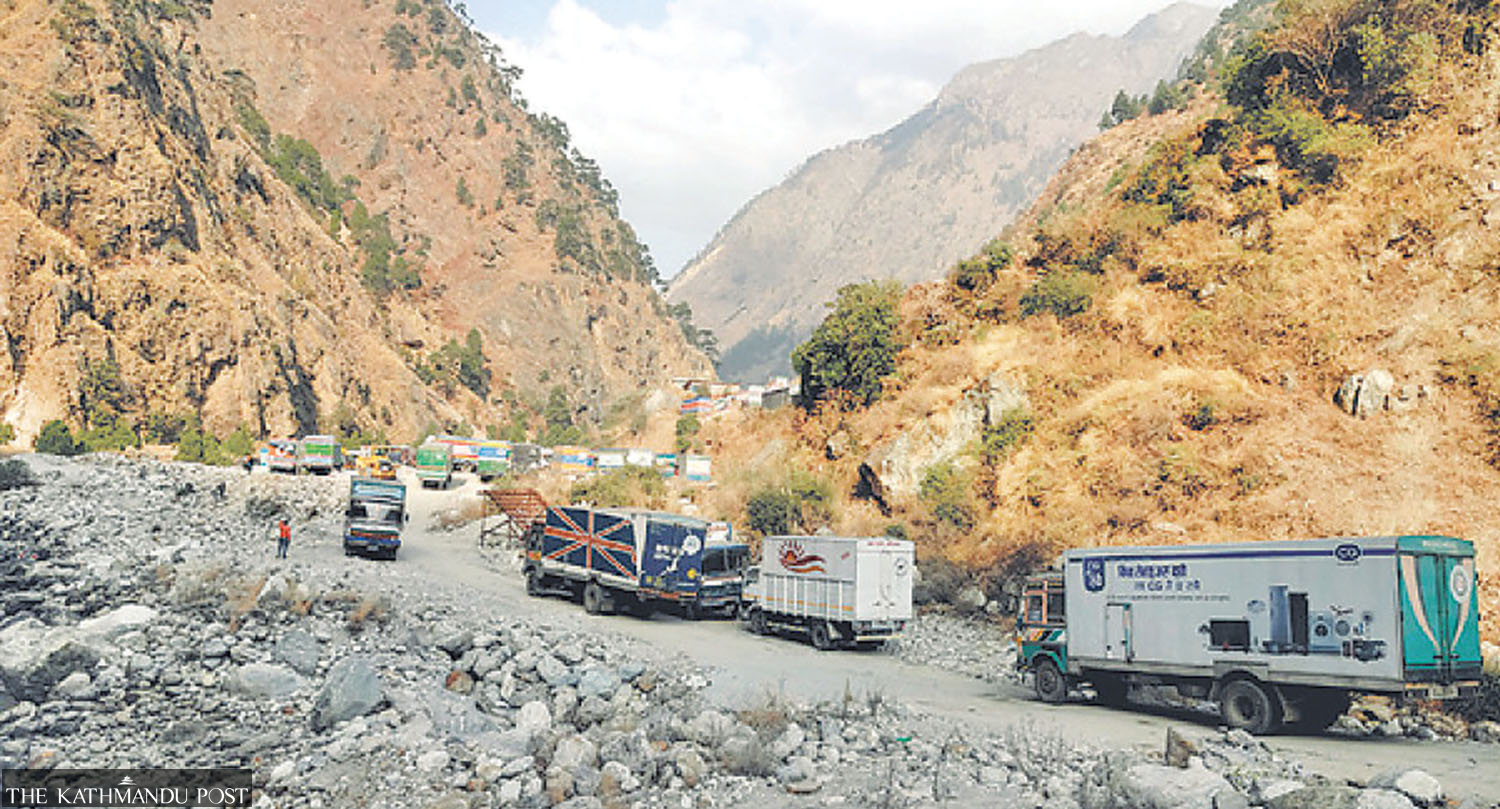
The Rasuwagadhi border with China closed during the Covid-19 pandemic. Post File Photo
Nepali importers of Chinese goods are bringing their shipments over the circuitous southern route through India instead of the direct way across the northern border because they don't know when it will be open or closed as per the on-again, off-again Chinese policy.
Traders say they are tired of the frequently changing Chinese transit rules and promises which have caused them massive losses.
On March 25, visiting Chinese Foreign Minister and State Councillor Wang Yi had assured Nepali officials that trade between Nepal and China would be eased. But traders say transportation problems still exist.
"Goods brought over the land route across the northern border may be held up at the point of entry as China does not allow full access to cargo vehicles plying between the two countries, and traders face losses as a result," said Ashok Kumar Shrestha, president of the Nepal Trans Himalayan Border Commerce Association.
Almost 80 percent of the traders are transporting their cargo by sea even though the route is longer, according to traders.
"The Chinese foreign minister during his visit to Nepal had said that the number of containers allowed to cross the border would be increased, and trade streamlined. Accordingly, the number of containers was increased immediately after the visit, but later the number was decreased again,” Shrestha said.
“We were hoping that after the Chinese foreign minister's visit, trade would be eased. But that did not happen. It seems China is not serious about trade with Nepal."
The Chinese had said 40 containers would be allowed to pass through the Tatopani border point and 28 containers through the Rasuwa border point daily, according to Shrestha. That promise was never fulfilled.
"China releases not more than 15 trucks daily through each of the two border points. Due to bad experiences in the past, traders have lost confidence in importing goods over the land route from China,” said Shrestha.
Nepal-bound cargo trucks have been stranded for months on the Chinese side of the border.
Traders have now started ordering goods targeting the Dashain and Tihar festivals.
Hydropower equipment and fruits are being brought across the northern border in limited quantities while readymade garments, electronic goods and footwear are coming over the sea route and through India, Shrestha said.
For the last two years, consignments from China have been arriving so late that they missed the festival shopping season. Traders who ordered goods in advance from China lost billions.
Kamal Prasad Bhattarai, director general of the Department of Customs, admitted that traders have been shifting towards the sea route.
“But it is due to potential floods and landslides during the rainy season in the northern route,” Bhattarai told the Post.
Nepal’s export has been disappointing as the production of exportable goods is not enough, officials say.
“To increase exports, Nepal needs to increase production," Bhattarai said, adding that trade with China has been gradually increasing after the Covid-19 pandemic.
According to the Department of Customs, Nepal imported goods worth Rs226.8 billion in the first 10 months of the current fiscal year ended mid-May, up from Rs183.1 billion in the same period last fiscal year.
Exports to China stood at Rs674.4 million in the first 10 months of the current fiscal year, down from Rs897.6 million in the same period last fiscal year. The trade deficit with the northern neighbour amounted to Rs226.1 billion in the first 10 months.

In the last fiscal year, Nepal imported goods worth Rs233.9 billion while exporting goods valued at just Rs1 billion. Post File PhotoIn the last fiscal year, Nepal imported goods worth Rs233.9 billion while the export of goods was valued at just Rs1 billion. China is Nepal's second largest trading partner after India.
Traders use the overland route across the northern border because consignments arrive within two weeks and transportation is cheaper than the sea route. According to them, importing goods over the sea route takes 40–60 days.
"As the monsoon has started, there are high chances of floods and landslides on the highway leading to the northern border, and this is another reason why traders have switched to the sea route," Shrestha said. “Exports to China through the northern border are almost zero.”
Nepal's exports to China include incense sticks, handicrafts (metal and wooden), noodles, pashmina, readymade garments, leather goods, rudraksha, tanned skin, tea, wheat flour and woollen carpets.
“China needs to consider Nepal as per the pledges it had made to ease the passage for trade, but that’s not happening,” said Chandra Ghimire, a former commerce secretary.
"Nepal’s trade deficit with China has increased to an unjustifiable ratio of 1:300," he said.
“We had assumed that following the transit treaty with China in 2018, Nepal’s exports to China would grow,” said Ghimire. “But exports to China fell after the signing of the transit treaty. The treaty never became functional and that’s very unfortunate.”
In May 2016, Nepal and China signed an agreement to provide access to seven Chinese sea and land ports for Nepal’s third-country trade.
In April 2019, the two neighbours signed the protocol on implementing the Trade and Transit Agreement. The signing of the protocol meant Nepal could use four Chinese sea ports in Tianjin, Shenzhen, Lianyungang and Zhanjiang, and three land ports in Lanzhou, Lhasa and Shigatse for third-country imports.
The agreement also allowed Nepal to carry out exports through six dedicated transit points between Nepal and China.
It’s been more than five years since the agreement was signed and over two years since the protocol was signed, but Nepal and China have yet to develop even the standard operating procedure for implementing the transit agreement.
Experts and former officials who took part in the negotiations to complete the agreement said the government failed to accord the required priority to implementing the pact.
The provision permitting third-country trade through China had also raised hopes that Nepal would finally be able to come out of its complete dependence on India.
For decades, Nepal has completely relied on India for its third-country trade for various reasons including historical relationship, open border and road infrastructure. But they sometimes have become an irritant for Nepal, as any obstructions along the border would lead to a shortage of goods in Nepal.
China closed its border points due to the pandemic in January 2020, and they have not been fully operationalised since then. China has made a number of pledges to ease the trade route.
The closure of the Chinese border in early 2020 has affected a large number of Nepali entrepreneurs exporting goods to China. The Kerung and Tatopani border points have been reopened, but both export and import trade have not picked up.













